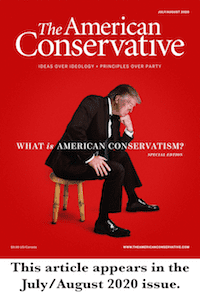The Fight on the Right: A Pre-Trump or Post-Trump Future?

Monty Python’s competing factions—the People’s Front of Judea, the Judean People’s Front, and the Judean Popular People’s Front—are funny not only because they cannot keep themselves straight, but also because they lampoon a very real phenomenon within political movements. People and organizations in broad agreement often fight with greater zeal amongst themselves than against their true opponents. Inventing and accentuating differences becomes a self-defeating prerequisite to asserting power.
Equally unhelpful, though, are efforts to preserve through sheer inertia a coalition whose organizing rationale has vanished. Ideas matter, and sometimes they conflict—about what we want and why, and how and when to pursue it. Progress comes when those conflicts are aired and resolved, not suppressed. The right side of the American political spectrum stands at such a juncture, with the obsolete “fusionism” of economic libertarians, social conservatives, and Cold War hawks fraying but its successor unclear. Terms like “liberaltarian,” “state-capacity libertarian,” “neoliberal,” “neoconservative,” “reformocon,” and “national conservative” seem to convey mood more than substance and can be delivered, depending on the speaker, with pride or a sneer. Among outside observers, confusion reigns.
As an active participant in this melee, I can hardly claim objectivity. But my proximity has both allowed and forced me to scrutinize the various ideological strands with all the care I can muster, searching for areas of common ground and disagreements in need of debate. From this work has come a taxonomy that might help to make sense of what we are all arguing about.
A Pre-Trump or Post-Trump Future?
It begins with the status quo: for a generation, the right-of-center’s economic agenda consisted primarily of expanding and empowering and deregulating and untaxing markets with an expectation that this would lead to widespread, broad-based growth and prosperity—the more faithfully the agenda was pursued the more quickly the tide would rise and, as the saying goes, a rising tide lifts all boats. This philosophy, which I call “Let the Market Rip,” remains the Republican Party’s default. Recall that the GOP’s only major legislative achievement while controlling Congress and the White House in 2017–18 was a massive tax cut.
Contemporary fights within the right-of-center are fundamentally fights about whether Let the Market Rip is working and, if not, what to do. Thus, the taxonomy’s first split separates competing evaluations of present conditions. Analysts on one branch see mostly success in the past generation’s policy environment, though of course they would prefer their vision had prevailed more often, and they have a laundry list of reforms that could make things even better. Material living standards, wages, and manufacturing output stand at all-time highs. Economic opportunity hasn’t declined too much and inequality, if it even matters, hasn’t risen too high. From this vantage point, John McCain’s 2008 presidential campaign had it right; so did Romney-Ryan and “Jeb!” The debates of the prior generation persist, between the libertarians and the supply-siders and the reformocons, but broadly speaking the desire is to go back to a pre-Trump future.
Opposite this branch is one committed to a post-Trump future. For a variety of reasons, this side considers America’s economic trajectory unsustainable or undesirable. Rather than emphasizing absolute consumption levels, they focus on slowing growth and innovation, stagnant productivity and wages, rising personal dependence on government transfers and national dependence on debt-financed imports, weakening families and communities and a widening gyre of social dysfunction, the “China Shock” and “Deaths of Despair”—ultimately, entire demographic and geographic swathes of the nation left behind. While Trump enthusiasts tend to land here, so too do those who hold no brief for the president but recognize many of the issues he raised as serious, or at least take his political success as a meaningful symptom of a deeper crisis. What comes after Trump, in this view, must depart substantially from what came before.
On one hand, all this leaves much room for agreement. Pre-Trumpism’s reforms are mostly ones that post-Trumpists might also support—school choice, tax simplification, environmental deregulation, and so on. For post-Trumpism, the problem is not that these ideas are bad, it’s that they are woefully inadequate and distract from more serious efforts. The post-Trumpist who considers a labor-market overhaul imperative and hears the pre-Trumpist reply, “let’s start by helping barbers move across state lines,” may react negatively. This is understandable but also unfortunate. Whatever else their disagreements, both sides can favor occupational licensing reform.
On the other hand, this asymmetry of agendas creates different perceptions of the depth of disagreement. To pre-Trumpists, the post-Trumpist can seem a Python-esque agitator. From their perspective, their entire agenda is a matter of consensus—if we all agree on our proposals, they might think, why not focus there? To the post-Trumpist, this attitude only underscores the distance between the sides and makes the other seem downright duplicitous. From his perspective, the common ground occupies but a small fraction of his entire agenda, and generally the least important part. Focusing on the areas of agreement becomes an implicit endorsement of the pre-Trumpist perspective, amplifying the instinct to ignore or denigrate those opportunities.
The Post-Trump Factions
In some respects, the distance between branches within post-Trumpism is greater than their respective distances from pre-Trumpism. Each departs from that common starting point, headed in a different direction. If the market has been failing too many people, two diametrically opposed responses might be available: Let the market rip and try to provide public support for all those left behind; or try to alter the market’s conditions, and channel or constrain its operation, so that its outcomes support a more stable society with prosperity more widely spread.
Of course, these responses represent two poles, and any number of agendas could occupy a middle ground that attempts to work at the problem from both sides.
The poles themselves are attractive and are defining the terms of the post-Trump debate, because they represent two conceptually coherent answers to the question of what conservatism really means. The partnership between economic libertarians and social conservatives that characterized the late 20th century’s fusionism worked because the minimalist economic policies prioritized by the libertarians appeared in practice to be supporting the social outcomes prioritized by the conservatives. Post-Trumpism, starting from the premise that this no longer works, asks, “what’s gonna give?”
One answer could be that the right-of-center’s non-negotiable starting point should be the free market and the pursuit of economic growth. Those priorities may necessitate a much larger safety net, widespread government dependence, and the loss of a baseline expectation that people everywhere can become productive contributors to their communities and form stable families capable of self-reliance. So be it.
This view is best represented by the Niskanen Center, which published a 2018 paper entitled “The Center Can Hold” that defined its goal as “reviving a decent, constructive center-right” and its vision as “the free-market welfare state.” The “China Shock,” its scholars argue, should be seen not “as a failure of trade policy” but rather “as an indictment of our inadequate social insurance system.” The real problem of “economic innovation and productivity growth [becoming] increasingly concentrated in big coast cities” is that it has become “harder and harder for people to move to where the jobs and opportunities are.”
The other answer to the question of what’s gonna give is that the right-of-center’s non-negotiable starting point should be the strong social fabric of self-reliant families and communities whose children will be capable of achieving the same, and the resilient nation capable of defending its interests. Those priorities may necessitate economic policy that channels investment toward goals beyond aggregate consumption, regulates and constrains activity that frustrates those goals, and sacrifices some GDP growth at least in the short run. So be it.
American Compass (of which I am the executive director) strives to advance this view. Its mission is to restore an economic consensus that emphasizes the importance of family, community, and industry to the nation’s liberty and prosperity. Our inaugural essay series, “Rebooting the American System,” offered the “comprehensive, conservative case for a return to robust national economic policy.”
The dichotomy between policy interventions that compensate for bad outcomes and interventions that generate better ones is a recurring theme in ideological debates. On the left-of-center, it has appeared recently in the context of Yale professor Jacob Hacker’s argument for “predistribution” as an alternative to redistribution. “Third way jujitsu,” he has written, “rested on two maxims: let markets be markets, and use redistribution to clean up afterward.” (This should sound familiar.) Instead, he argues, policymakers should focus on “making markets work for the middle class” by formulating policies that reduce gains for some and increase gains for others in the market—for instance, one might seek to strengthen worker bargaining power, change norms of corporate governance and executive pay, or reorient the education system toward serving those who will not complete college.
Another formulation contrasts the goals of “high-wage/low-welfare” and “low-wage/high-welfare” models for a nation’s political economy. Ensuring that firms have access to the cheapest possible labor, both domestically and abroad, can yield strong GDP growth, but it necessitates substantial state support for many of the participants. Firms forced to succeed with higher-cost labor will have to adopt strategies responding to that challenge, but they will also benefit from higher productivity, lower taxes, and more prosperous households. Either approach might be sustainable, but the social, political, and economic outcomes differ dramatically.
I have tried thus far to describe at least somewhat fairly and neutrally these debates, but allow me to return in closing to my role as a participant. I believe that the Niskanen approach is fatally flawed in both theory and practice. As a theoretical matter, it is not conservative under any useful definition of the term. It promotes itself as committed to the “free market,” but its expansion of the safety net assigns to government a role that invariably invades the market anyway and, worse, undermines the individual liberty, private ordering, and mediating institutions that conservatives so value markets for supporting. The free market is a powerful tool for pursuing the conservative’s conception of the common good. Trampling the ends on behalf of the means yields a pyrrhic victory at best.
As Professor Hacker’s dismissal of “third way jujitsu” suggests, the Niskanen vision in fact most closely approximates former (Democratic) president Obama’s own approach. When asked how “The Center Can Hold” differed from the Obama administration’s vision, Niskanen president Jerry Taylor first promised an answer but then tacked in a different direction, suggesting, “the better question might be how Obama’s policy vision differed from moderate Republicanism.” 
The Obama comparison is not an indictment per se. That brand of technocratic progressivism deserves a voice in Washington, especially as the Democratic Party itself drifts leftward into a fog. But this obviously is not the direction that America’s right-of-center should, or will, go. Nor, in the final analysis, is it even a valid brand of post-Trumpism. Insofar as conservatives are prepared to reject the status quo policy environment as insufficient, it is precisely because the prior generation’s formula of growth-for-some-plus-redistribution-for-the-rest has failed. A proposal to double down in response is rightly dead on arrival.
For conservatives, what’s gotta give is the market fundamentalism that has constrained their thinking and frustrated the pursuit of their own goals. Pre-Trumpism remains a dominant force, thanks to institutional inertia fostering a desperate hope that this too shall pass and all can return to the way it was. As the growing ranks of dissidents within those institutions recognize, allowing that inertia to prevail would be folly, and a better alternative exists.
Oren Cass is the executive director of American Compass and the author of The Once and Future Worker by Encounter Books.
Comments